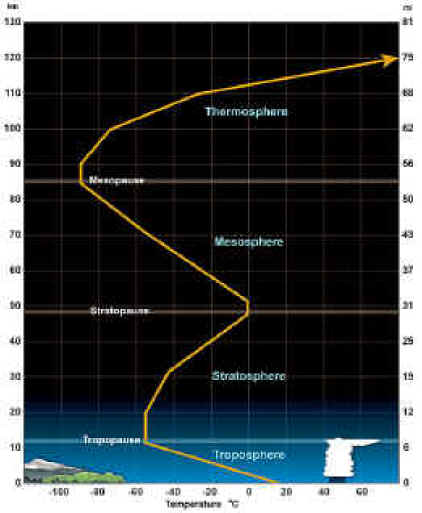
Weather Basics
Welcome to North Georgia Today weather basics. The goal of this project is to help you understand how the weather works. Chapters are numbered, so you can keep track of where you are. You can start when and where you wish and stop when and where you wish. Most of the core materials in this course have been developed by the National Weather Service, but we may add some content of weather from time to time. This material is 100% free to study.
Introduction to the Atmosphere
The atmosphere is a cloud of gas and suspended solids extending from the Earth's surface out many thousands of miles, becoming increasingly thinner with distance but always held by the Earth's gravitational pull.
The atmosphere surrounds the Earth and holds the air we breathe; it protects us from outer space; and holds moisture (clouds), gases, and tiny particles. In short, the atmosphere is the protective bubble in which we live.
Chemical makeup of the atmosphere EXCLUDING water vapor Gas Symbol Content Nitrogen N2 78.084% 99.998%
Oxygen O2 20.947% Argon Ar 0.934% Carbon dioxide CO2 0.033% Neon Ne 18.20 parts per million Helium He 5.20 parts per million Krypton Kr 1.10 parts per million Sulfur dioxide SO2 1.00 parts per million Methane CH4 2.00 parts per million Hydrogen H2 0.50 parts per million Nitrous oxide N2O 0.50 parts per million Xenon Xe 0.09 parts per million Ozone O3 0.07 parts per million Nitrogen dioxide NO2 0.02 parts per million Iodine I2 0.01 parts per million Carbon monoxide CO trace Ammonia NH3 trace This protective bubble consists of several gases (listed in the table to the right) with the top four making up 99.998% of all gases. Of the dry composition of the atmosphere nitrogen, by far, is the most common. Nitrogen dilutes oxygen and prevents rapid burning at the Earth's surface. Living things need it to make proteins.
Oxygen is used by all living things and is essential for respiration. It is also necessary for combustion or burning.
Argon is used in light bulbs, in double-pane windows, and used to preserve the original Declaration of Independence and the Constitution. Plants use carbon dioxide to make oxygen. Carbon dioxide also acts as a blanket that prevents the escape of heat into outer space.
These percentages of atmospheric gases are for a completely dry atmosphere. The atmosphere is rarely, if ever, dry. Water vapor (water in a 'gas' state) is nearly always present up to about 4% of the total volume.
Chemical makeup of the atmosphere INCLUDING water vapor Water Vapor Nitrogen Oxygen Argon 0% 78.084% 20.947% 0.934% 1% 77.30% 20.70% 0.92% 2% 76.52% 20.53% 0.91% 3% 75.74% 20.32% 0.90% 4% 74.96% 20.11% 0.89% In the Earth's desert regions (30°N/S) when dry winds are blowing, the water vapor contribution to the composition of the atmosphere will be near zero.
Water vapor contribution climbs to near 3% on extremely hot/humid days. The upper limit, approaching 4%, is found in tropical climates. The table shows the changes in atmospheric composition with the inclusion of different amounts of water vapor.
Layers of the Atmosphere
The envelope of gas surrounding the Earth changes from the ground up. Five distinct layers have been identified using...
- thermal characteristics (temperature changes),
- chemical composition,
- movement, and
- density.
Each of the layers are bounded by "pauses" where the greatest changes in thermal characteristics, chemical composition, movement, and density occur.


Exosphere
This is the outermost layer of the atmosphere. It extends from the top of the thermosphere to 6,200 miles (10,000 km) above the earth. In this layer, atoms and molecules escape into space and satellites orbit the earth. At the bottom of the exosphere is the thermopause located around 375 miles (600 km) above the earth.
Thermosphere
Between about 53 miles (85 km) and 375 miles (600 km) lies the thermosphere. This layer is known as the upper atmosphere. While still extremely thin, the gases of the thermosphere become increasingly more dense as one descends toward the earth.
As such, incoming high energy ultraviolet and x-ray radiation from the sun begins to be absorbed by the molecules in this layer and causes a large temperature increase.
Because of this absorption, the temperature increases with height. From as low as -184°F (-120°C) at the bottom of this layer, temperatures can reach as high as 3,600°F (2,000°C) near the top.
However, despite the high temperature, this layer of the atmosphere would still feel very cold to our skin due to the very thin atmosphere. The high temperature indicates the amount of the energy absorbed by the molecules but with so few in this layer, the total number of molecules is not enough to heat our skin.
The Ionosphere

This absorption of radiation is also responsible for the ionosphere. Located within the thermosphere, the ionosphere is made of electrically charged gas particles (ionized).
The ionosphere extends from 37 to 190 miles (60-300 km) above the earth's surface. It is divided into three regions or layers; the F-Region, E-Layer and D-Layer. During the daytime the F-Layer splits into two layers then recombines at night.
The E-Layer was discovered first. In 1901, Guglielmo Marconi transmitted a signal between Europe and North America and showed that it had to bounce off an electrically conducting layer about 62 miles (100 km) altitude. In 1927, Sir Edward Appleton named that conducting layer the (E)lectrical-Layer. Additional conducting layers discovered later were simply called the D-Layer and F-Layer.
Since the ionosphere's existence is due to radiation from the sun striking the atmosphere, it changes in density from daytime to nighttime. All three layers are more dense during the daytime. At night, all layers decrease in density with the D-Layer undergoing the greatest change. At night the D-Layer essentially disappears.
As seen around the 1900's, the ionosphere has the important quality of bouncing radio signals transmitted from the earth. Its existence is why places all over the world can be reached via radio.

Mesosphere
This layer extends from around 31 miles (50 km) above the Earth's surface to 53 miles (85 km). The gases, including the oxygen molecules, continue to become more dense as one descends. As such, temperatures increase as one descends rising to about 5°F (-15°C) near the bottom of this layer.
The gases in the mesosphere are now thick enough to slow down meteors hurtling into the atmosphere, where they burn up, leaving fiery trails in the night sky. Both the stratosphere (next layer down) and the mesosphere are considered the middle atmosphere. The transition boundary which separates the mesosphere from the stratosphere is called the stratopause.
Stratosphere
The Stratosphere extends around 31 miles (50 km) down to anywhere from 4 to 12 miles (6 to 20 km) above the Earth's surface. This layer holds 19 percent of the atmosphere's gases but very little water vapor.
In this region the temperature increases with height. Heat is produced in the process of the formation of Ozone and this heat is responsible for temperature increases from an average -60°F (-51°C) at tropopause to a maximum of about 5°F (-15°C) at the top of the stratosphere.
This increase in temperature with height means warmer air is located above cooler air. This prevents "convection" as there is no upward vertical movement of the gases. As such the location of the bottom of this layer is readily seen by the 'anvil-shaped' tops of cumulonimbus clouds.
Troposphere
Known as the lower atmosphere almost all weather occurs in this region. The troposphere begins at the Earth's surface and extends from 4 to 12 miles (6 to 20 km) high.
The height of the troposphere varies from the equator to the poles. At the equator it is around 11-12 miles (18-20 km) high, at 50°N and 50°S, 5½ miles and at the poles just under four miles high.
As the density of the gases in this layer decrease with height, the air becomes thinner. Therefore, the temperature in the troposphere also decreases with height in response. As one climbs higher, the temperature drops from an average around 62°F (17°C) to -60°F (-51°C) at the tropopause.